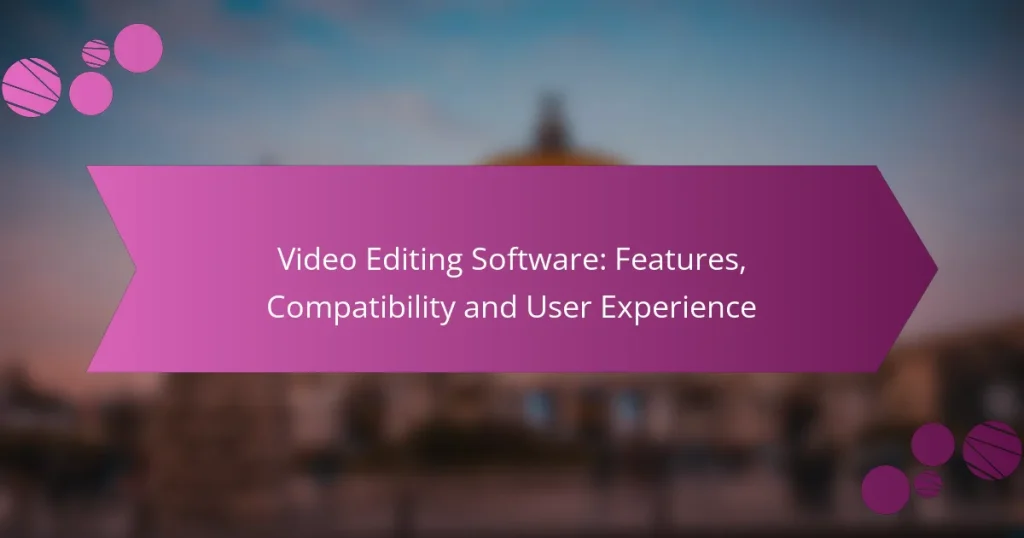Choosing the right video editing software is essential for achieving high-quality results tailored to your specific needs. With a variety of options available, such as Adobe Premiere Pro and Final Cut Pro, it’s important to consider features, compatibility, and user experience to enhance your editing workflow. By evaluating your skill level, budget, and hardware, you can find a program that best suits your creative goals.
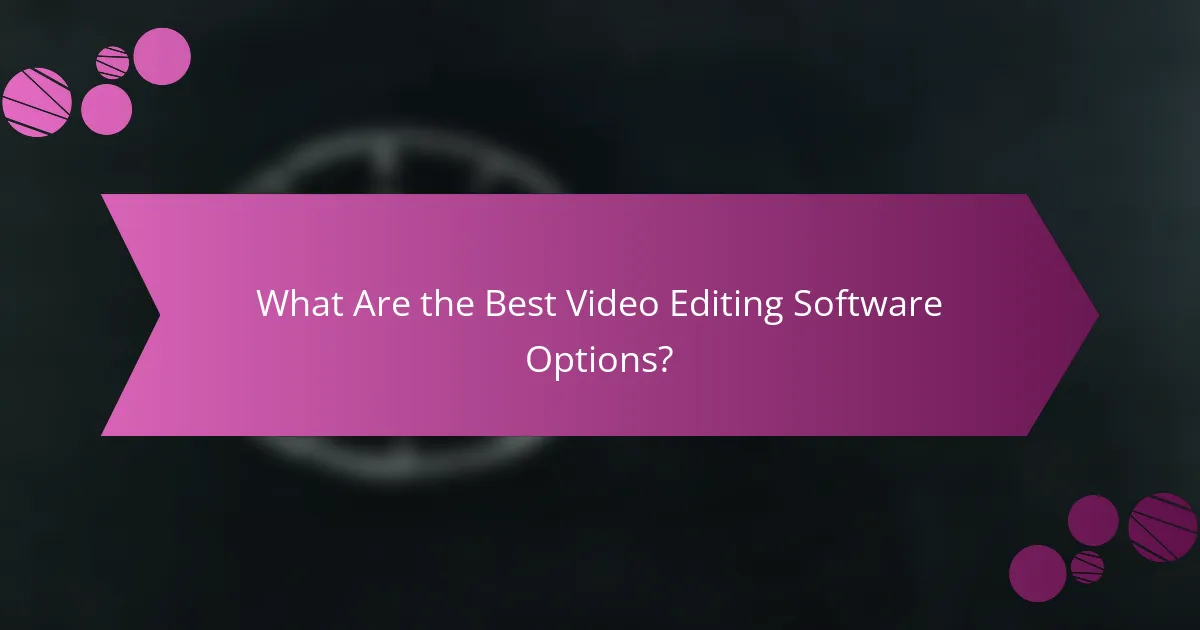
What Are the Best Video Editing Software Options?
The best video editing software options vary based on user needs, budget, and platform compatibility. Popular choices include Adobe Premiere Pro, Final Cut Pro, DaVinci Resolve, HitFilm Express, and Filmora, each offering unique features and user experiences.
Adobe Premiere Pro
Adobe Premiere Pro is a leading video editing software known for its robust features and flexibility. It supports a wide range of formats and integrates seamlessly with other Adobe products, making it ideal for professionals and serious enthusiasts.
Key features include multi-camera editing, advanced color grading, and a vast library of effects. However, it operates on a subscription model, which can add up over time, so consider your budget before committing.
Final Cut Pro
Final Cut Pro is Apple’s flagship video editing software, designed exclusively for macOS users. It offers a user-friendly interface and powerful tools, making it suitable for both beginners and experienced editors.
Its magnetic timeline and advanced media organization features streamline the editing process. While it has a one-time purchase price, it may not be the best choice for those who need cross-platform compatibility.
DaVinci Resolve
DaVinci Resolve is renowned for its advanced color correction and audio post-production capabilities. It offers a free version with substantial features, making it accessible for beginners and budget-conscious users.
The software combines editing, color grading, and audio mixing in one platform, which can simplify workflows. However, the learning curve may be steep for new users, so patience and practice are essential.
HitFilm Express
HitFilm Express is a free video editing software that caters to aspiring filmmakers and content creators. It provides a range of professional-grade features, including visual effects and compositing tools.
While the free version is robust, additional features can be purchased as add-ons. This software is particularly beneficial for those looking to create high-quality videos without a financial investment.
Filmora
Filmora is a user-friendly video editing software that appeals to beginners and casual users. It offers a simple drag-and-drop interface, making it easy to create videos quickly.
With a variety of built-in effects, transitions, and music, Filmora allows for creative expression without overwhelming users. However, it may lack some advanced features found in professional software, so consider your editing needs before choosing this option.
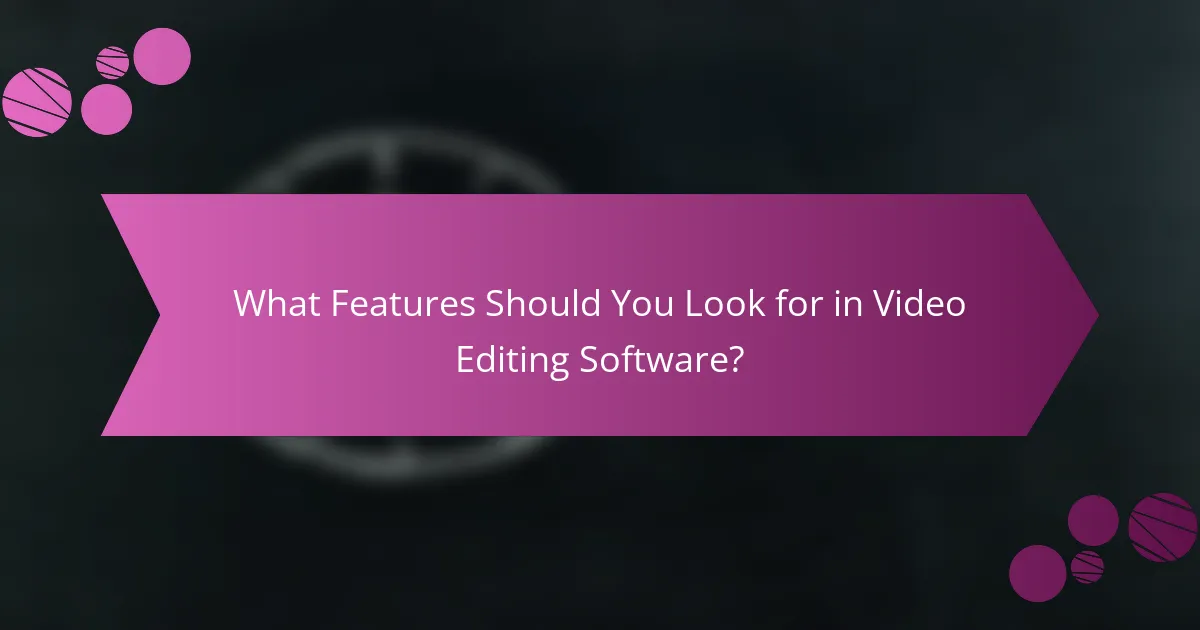
What Features Should You Look for in Video Editing Software?
When selecting video editing software, prioritize features that enhance your editing workflow and output quality. Key aspects to consider include multi-track editing, color correction tools, audio editing capabilities, and export options.
Multi-track editing
Multi-track editing allows you to layer multiple video and audio clips simultaneously, which is essential for complex projects. This feature enables you to synchronize audio with video, add background music, and incorporate sound effects without losing the original audio track.
Look for software that supports a flexible timeline, allowing you to easily manipulate and arrange tracks. Popular options often include drag-and-drop functionality, making it user-friendly for both beginners and experienced editors.
Color correction tools
Color correction tools are vital for enhancing the visual quality of your videos. These tools help adjust brightness, contrast, saturation, and color balance to achieve a polished look. Many software options offer built-in presets for quick adjustments, as well as advanced features for detailed color grading.
Consider software that provides a color wheel or histogram for precise control over color adjustments. This can significantly improve the overall mood and aesthetic of your project, making it more engaging for viewers.
Audio editing capabilities
Effective audio editing capabilities are crucial for ensuring clear sound quality in your videos. Look for software that allows you to adjust volume levels, remove background noise, and add audio effects like reverb or echo. Some programs even offer built-in audio mixing tools for a more professional sound.
Additionally, consider options that support various audio formats and allow for easy synchronization with video tracks. This will streamline your editing process and enhance the final product’s quality.
Export options
Export options determine how you can save and share your finished videos. Look for software that supports multiple formats such as MP4, MOV, and AVI, as well as resolutions ranging from standard definition to 4K. This flexibility ensures compatibility with various platforms and devices.
Consider whether the software allows for direct uploads to social media or video-sharing sites, which can save time. It’s also beneficial to check if it offers customizable export settings, enabling you to optimize file size and quality based on your needs.
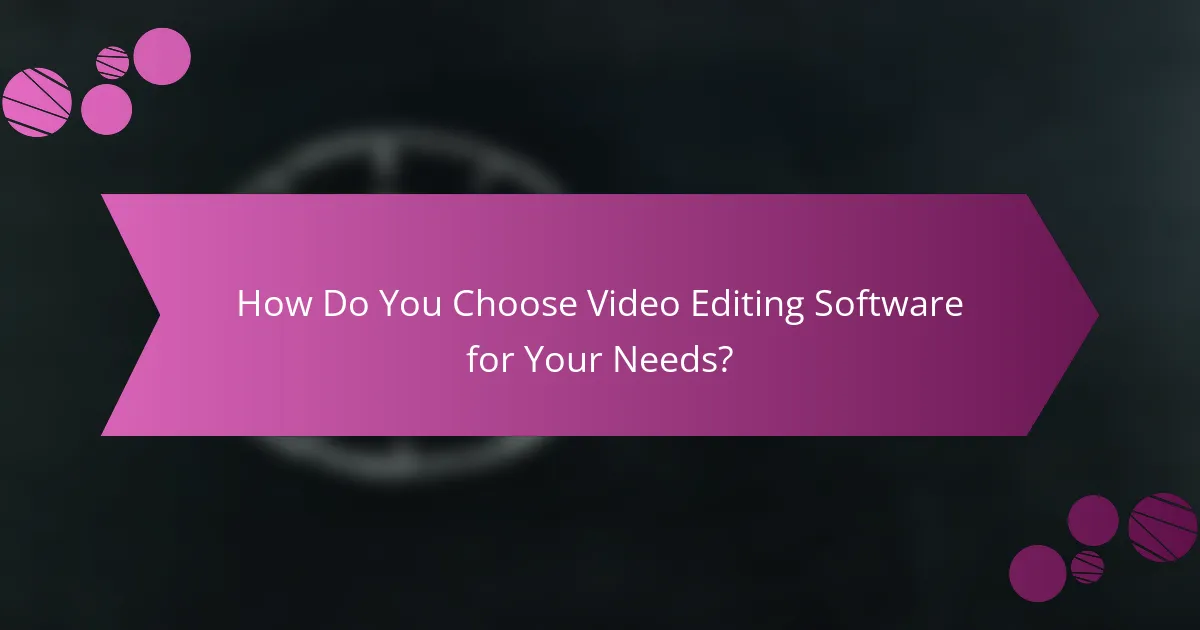
How Do You Choose Video Editing Software for Your Needs?
Choosing video editing software involves assessing your specific requirements, including your skill level, budget, and hardware compatibility. A well-suited program can enhance your editing experience and streamline your workflow.
Assess your skill level
Your skill level is a crucial factor in selecting video editing software. Beginners may benefit from user-friendly interfaces with basic features, while advanced users might prefer software with more complex tools and functionalities.
Consider starting with entry-level options like iMovie or Windows Movie Maker if you are new to video editing. For those with more experience, programs like Adobe Premiere Pro or Final Cut Pro offer advanced capabilities that cater to professional needs.
Consider your budget
Budget constraints can significantly influence your choice of video editing software. Prices can range from free options to several hundred dollars for professional-grade tools. Determine how much you are willing to invest based on your editing needs.
Free software like DaVinci Resolve provides robust features without a cost, while subscription-based services like Adobe Creative Cloud offer extensive resources but may add up over time. Weigh the benefits against your budget to find the best fit.
Evaluate hardware compatibility
Hardware compatibility is essential for optimal performance in video editing. Ensure that your computer meets the software’s system requirements, including processor speed, RAM, and graphics capabilities.
For instance, software like Final Cut Pro is exclusive to macOS, while others like Adobe Premiere Pro work on both Windows and macOS. Check for any additional requirements, such as specific graphics cards or storage space, to avoid performance issues during editing.
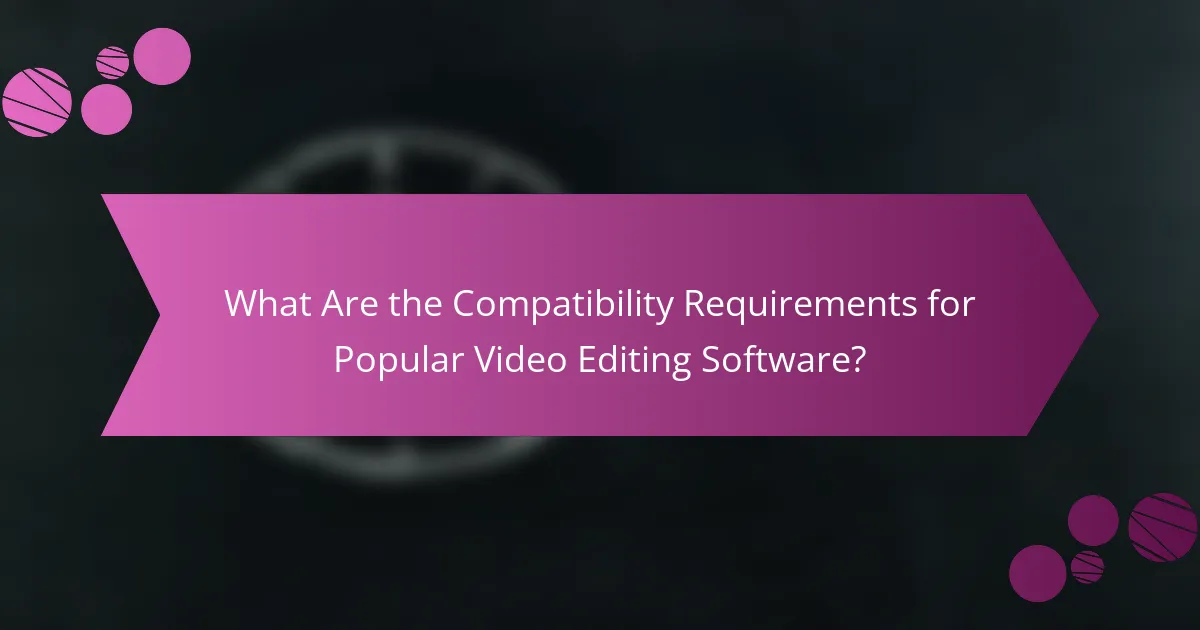
What Are the Compatibility Requirements for Popular Video Editing Software?
Compatibility requirements for video editing software vary by program and can significantly impact performance. Users should ensure their hardware meets the necessary specifications to achieve optimal editing experiences.
Adobe Premiere Pro system requirements
Adobe Premiere Pro requires a compatible operating system, typically Windows 10 (64-bit) or macOS 10.14 or later. Users should have at least 8 GB of RAM, though 16 GB or more is recommended for smoother performance.
Graphics hardware is also crucial; a GPU with DirectX 12 support for Windows or Metal support for macOS is necessary. Additionally, a minimum of 2 GB of GPU VRAM is recommended for HD media, while 4 GB or more is ideal for 4K editing.
Final Cut Pro compatibility with macOS
Final Cut Pro is exclusively compatible with macOS, requiring macOS 11.5 or later. Users should have at least 4 GB of RAM, but 8 GB or more is advisable for better performance, especially when handling high-resolution projects.
For optimal use, a Mac with an Apple silicon chip or a Mac with an Intel processor and a dedicated GPU is recommended. This ensures that users can take full advantage of the software’s advanced features and rendering capabilities.
DaVinci Resolve hardware specifications
DaVinci Resolve is available for Windows, macOS, and Linux, with specific hardware requirements depending on the operating system. A minimum of 16 GB of RAM is recommended, with 32 GB or more preferred for complex projects.
Graphics cards play a significant role in performance; a GPU with at least 4 GB of VRAM is essential for HD editing, while 8 GB or more is recommended for 4K and higher resolutions. Users should also ensure their system has a fast SSD for storage to facilitate smooth playback and editing.
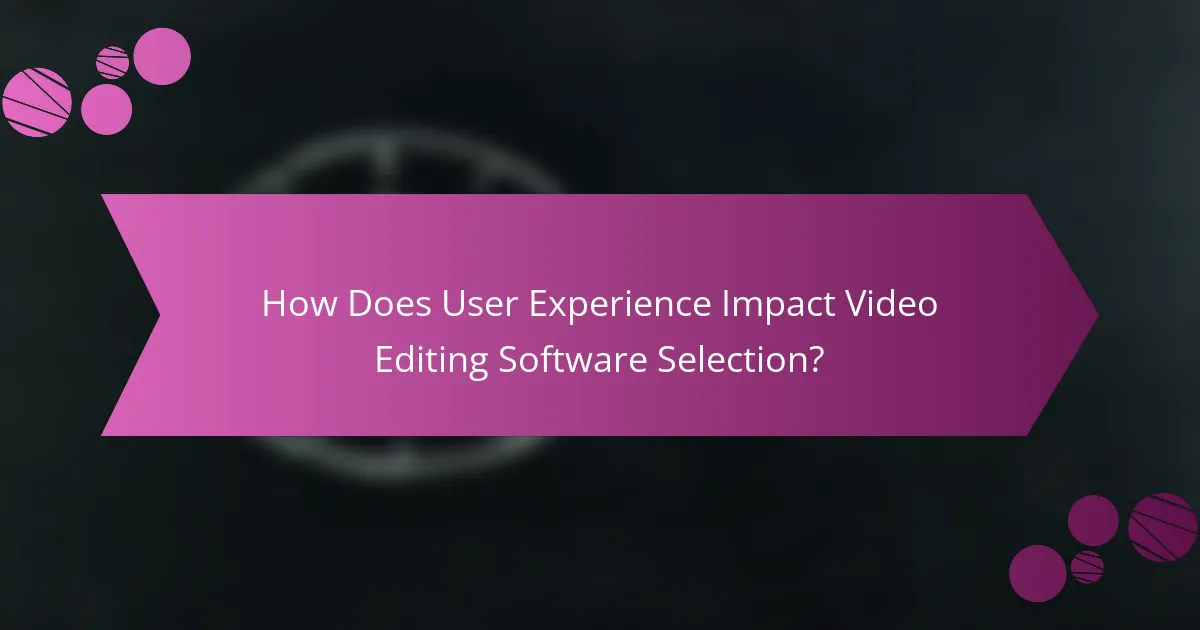
How Does User Experience Impact Video Editing Software Selection?
User experience plays a crucial role in selecting video editing software, as it directly affects how efficiently users can navigate and utilize the program. A positive user experience can enhance productivity, while a poor one may lead to frustration and wasted time.
Interface design
The interface design of video editing software significantly influences user experience. A clean, intuitive layout allows users to locate tools and features quickly, reducing the time spent searching for functions. Look for software that offers customizable workspaces, as this can help tailor the interface to individual preferences.
Consider the visual hierarchy of the interface as well. Important tools should be easily accessible, while less frequently used options can be tucked away in menus. Software with a cluttered or confusing interface can hinder workflow and lead to errors.
Learning curve
The learning curve of video editing software varies widely among different programs. Some applications are designed for beginners, featuring guided tutorials and simplified workflows, while others cater to advanced users with complex features and capabilities. Assess your skill level and choose software that matches your experience.
To ease the learning process, look for software that offers extensive online resources, such as video tutorials, forums, and user guides. A supportive community can be invaluable for troubleshooting and learning new techniques.
Customer support options
Customer support options are essential when selecting video editing software, as they can significantly impact your overall experience. Look for software that provides multiple support channels, such as live chat, email, and phone support. This ensures you can get help quickly when issues arise.
Additionally, consider the availability of a knowledge base or FAQ section. Comprehensive documentation can help you resolve common problems without needing direct assistance. Check user reviews to gauge the responsiveness and effectiveness of the customer support offered by the software provider.
